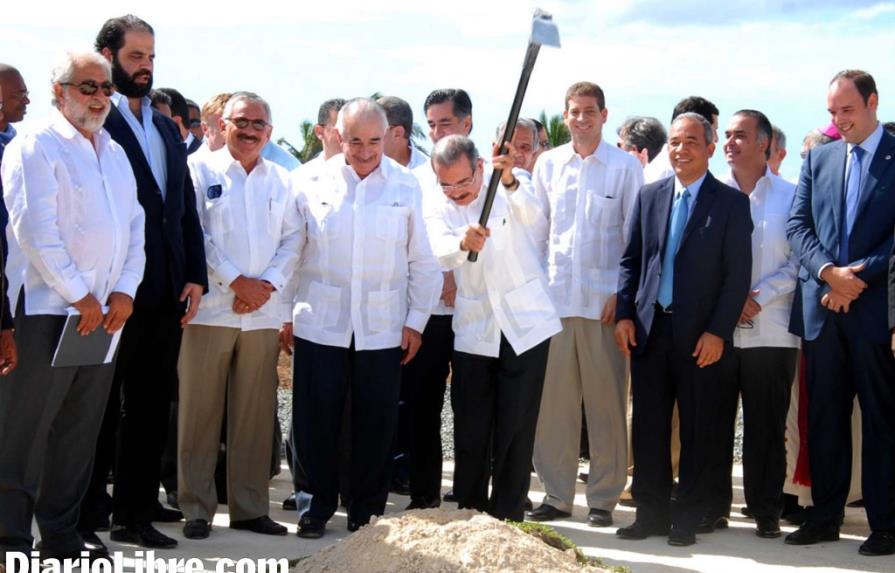Natural gas: an energy appetite that will have to wait in the Dominican Republic
Bichara says that they are asking for a guarantee of up to US $5 billion

SD. On Wednesday, 12 August, Ruben Bichara the executive Vice President of the Dominican Corporation of State - owned Electricity Enterprises (CDEEE), returned from his fifth trip to Washington where he had gone "to look for gas."
In his meeting with the authorities from the Department of State of the United States, there were also representatives of private American companies that exploit natural gas deposits. "I'm going to tell you what they said to me at the Department of State," Bichara said. And immediately he reported: "Do you know how much the American company asked me for as a credit guarantee for a gas contract? US $4.0 to US $5.0 billion!"
If he were to be asked why the Dominican government opted for the coal-fired plants, in spite of their environmental impact, he would answer: "There was no other option."
During 2009 or perhaps 2010, when the country was run by Leonel Fernandez, the Brazilian company Odebrecth received from the government a proposal to construct a natural gas generating plant with a capacity of producing 600 MW.
"They found the financing, the equipment, the land, everything," but when they were going to begin the job, "they could not find any gas," he told reporters.
And this precedent directly impacted that the same Odebrecth would win the tender for the construction of the two coal-fired generators carried out by CDEEE last October. It was like this according to Bichara, because after dealing with the failure of their attempts to obtain a contract for supplying natural gas on a long-term basis (the norm is a 20 year contract), the company made the counterproposal to construct a coal-fired generator. In order for them to do this, they carried out a study "which cost 10 million pesos," a copy of which Bichara himself showed a group of reporters and journalists with which he met last 14 August.
At that time, this study was presented to President Leonel Fernandez, who "authorized the conversion of the project to coal." Then the talk about modifying the energy matrix with an emphasis on gas begins to reflect a preference for coal.
For example, on 22 may 2007 President Leonel Fernandez issued decree 264 - 07 which declares "as a national priority" the massive use of natural gas as a measure to reduce the oil bills. In this context on 19 November 2011, the CDEEE, at that time headed by businessman Celso Marranzini, convened an international tender for the construction of a generating plant of up to 1000 MW using either natural gas or coal.
Bichara tells how in Costa Rica President Barack Obama declared that the countries of Central America and the Caribbean could count on natural gas starting in 2020. "He said so in my presence, I was sitting there," he remarked.
Before that year, and with "a good negotiation," it would be possible to obtain a small amount of natural gas in 2016 or 2017, which could be used in the conversion of the Cogentrix plant which uses the most expensive fuel, fuel oil number two.
Because of its high cost, this generator is paid in US $4.8 million a month so that it stays turned off. He also said that this little bit of gas could be obtained sooner, "if they can achieve an agreement" that it will be used for another generator in the East area.
The case of the generating plants Quisqueya I and Quisqueya II illustrates this present situation. Inaugurated on 22 September 2013 with an installed capacity of 430 MW they were made to be able to function with natural gas or with fuel oil number two.
Operating with fuel oil costs US $0.258 cents a kilowatt hour, while if it was done with natural gas, this cost (which is the same as the AES Dominicana generators produce, thanks to their long term contract which ends in 2022) comes out to US $0.103 cents of a dollar.
Compared with the costs at AES, Quisqueya I and Quisqueya II produce electricity 2.5 times more expensive, simply because they have not been able to obtain an international contact for the supply of natural gas.
On 10 October 2012, businessman Miguel Feris Iglesias inaugurated, in the presence of President Danilo Medina his 25 MW electricity generating plant based on natural gas "Los Origenes Power Plant," which implied an investment of US $70 million.
"Because of this you see that there are plants that converted to gas, such as the case of Feris Igpesias, and have not been able to start up with gas, because of the cost of gas on the market at this moment," commented the official.
The world that ran out of gas
In March 2011, there was an earthquake of 9.0 on the Richter scale, in Fukushima, Japan, which was followed by a tsunami of some 38 m. Its impact on the nuclear power plants installed there, caused another high intensity earthquake in the natural gas markets, where the electricity industry of the Asiatic countries went to find refuge, signing long-term contracts for all of the production of this fuel. For this reason there is no natural gas.
In his meeting with the authorities from the Department of State of the United States, there were also representatives of private American companies that exploit natural gas deposits. "I'm going to tell you what they said to me at the Department of State," Bichara said. And immediately he reported: "Do you know how much the American company asked me for as a credit guarantee for a gas contract? US $4.0 to US $5.0 billion!"
If he were to be asked why the Dominican government opted for the coal-fired plants, in spite of their environmental impact, he would answer: "There was no other option."
During 2009 or perhaps 2010, when the country was run by Leonel Fernandez, the Brazilian company Odebrecth received from the government a proposal to construct a natural gas generating plant with a capacity of producing 600 MW.
"They found the financing, the equipment, the land, everything," but when they were going to begin the job, "they could not find any gas," he told reporters.
And this precedent directly impacted that the same Odebrecth would win the tender for the construction of the two coal-fired generators carried out by CDEEE last October. It was like this according to Bichara, because after dealing with the failure of their attempts to obtain a contract for supplying natural gas on a long-term basis (the norm is a 20 year contract), the company made the counterproposal to construct a coal-fired generator. In order for them to do this, they carried out a study "which cost 10 million pesos," a copy of which Bichara himself showed a group of reporters and journalists with which he met last 14 August.
At that time, this study was presented to President Leonel Fernandez, who "authorized the conversion of the project to coal." Then the talk about modifying the energy matrix with an emphasis on gas begins to reflect a preference for coal.
For example, on 22 may 2007 President Leonel Fernandez issued decree 264 - 07 which declares "as a national priority" the massive use of natural gas as a measure to reduce the oil bills. In this context on 19 November 2011, the CDEEE, at that time headed by businessman Celso Marranzini, convened an international tender for the construction of a generating plant of up to 1000 MW using either natural gas or coal.
Bichara tells how in Costa Rica President Barack Obama declared that the countries of Central America and the Caribbean could count on natural gas starting in 2020. "He said so in my presence, I was sitting there," he remarked.
Before that year, and with "a good negotiation," it would be possible to obtain a small amount of natural gas in 2016 or 2017, which could be used in the conversion of the Cogentrix plant which uses the most expensive fuel, fuel oil number two.
Because of its high cost, this generator is paid in US $4.8 million a month so that it stays turned off. He also said that this little bit of gas could be obtained sooner, "if they can achieve an agreement" that it will be used for another generator in the East area.
The case of the generating plants Quisqueya I and Quisqueya II illustrates this present situation. Inaugurated on 22 September 2013 with an installed capacity of 430 MW they were made to be able to function with natural gas or with fuel oil number two.
Operating with fuel oil costs US $0.258 cents a kilowatt hour, while if it was done with natural gas, this cost (which is the same as the AES Dominicana generators produce, thanks to their long term contract which ends in 2022) comes out to US $0.103 cents of a dollar.
Compared with the costs at AES, Quisqueya I and Quisqueya II produce electricity 2.5 times more expensive, simply because they have not been able to obtain an international contact for the supply of natural gas.
On 10 October 2012, businessman Miguel Feris Iglesias inaugurated, in the presence of President Danilo Medina his 25 MW electricity generating plant based on natural gas "Los Origenes Power Plant," which implied an investment of US $70 million.
"Because of this you see that there are plants that converted to gas, such as the case of Feris Igpesias, and have not been able to start up with gas, because of the cost of gas on the market at this moment," commented the official.
The world that ran out of gas
In March 2011, there was an earthquake of 9.0 on the Richter scale, in Fukushima, Japan, which was followed by a tsunami of some 38 m. Its impact on the nuclear power plants installed there, caused another high intensity earthquake in the natural gas markets, where the electricity industry of the Asiatic countries went to find refuge, signing long-term contracts for all of the production of this fuel. For this reason there is no natural gas.


 Edwin Ruiz
Edwin Ruiz
 Edwin Ruiz
Edwin Ruiz